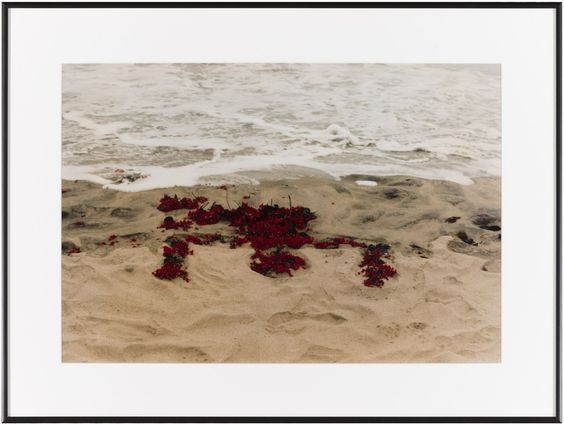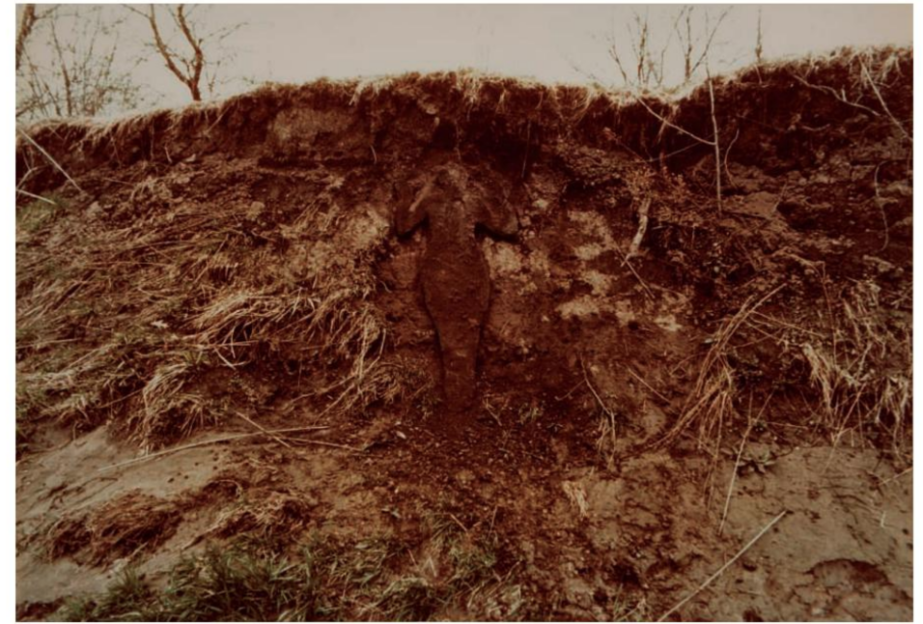
Anne Carson, from “The Glass Essay”, from Glass, Irony and God
Ana Mendieta, Anima (Alma/Soul), 1976, armature of bamboo and rope with fireworks, Oaxaca, Mexico, c-print on paper mounted on paperboard and printed, 1977

Anne Carson, from “The Glass Essay”, from Glass, Irony and God
Ana Mendieta, Anima (Alma/Soul), 1976, armature of bamboo and rope with fireworks, Oaxaca, Mexico, c-print on paper mounted on paperboard and printed, 1977

ana mendieta

Ana Mendieta, American, b. Cuba, 1948–1985
Untitled from the Silueta series, 1973–77
Silver dye-bleach print
Sheet for parts 1, 6, 9, 10: 15 7/8 × 19 7/8 in. (40.3 × 50.5 cm); sheet for parts 2, 3, 4, 5, 7, 8, 11, 12: 19 7/8 × 15 7/8 in. (50.5 × 40.3 cm)
Collection Museum of Contemporary Art Chicago, Gift from The Howard and Donna Stone Collection, 2002.46.6
Photo: Nathan Keay, © MCA Chicago

Ana Mendieta, Silueta series, 1978, c print

Ana Mendieta from TRACES at Hayward Gallery

Ana Mendieta, Blood and Feathers, 1974
Following text taken from Tate:
“Untitled (Blood and Feathers #2) is a short three and a half minute film documenting a performance that the artist undertook at Old Man’s Creek, Sharon Center, Iowa City, Iowa. The performance was recorded on Super-8 film and 35mm slides (reproduced Viso 2004, p.215). The film shows Mendieta standing naked on the sandy bank on one side of the creek, in front of flowing water and a steep mud bank on the other side. After looking directly at the camera, she raises a flask to shoulder level and begins pouring blood down her chest, legs and stomach. She then reaches over her shoulders to include her back, and covers her arms before casting the empty vessel aside. Dropping to the ground, she plunges face-first into a heap of white feathers where she slowly rolls back and forth, adhering the feathers to the sticky blood on her skin. Finally, she rises slowly to stand with her arms held away from her body but bent at the elbow as though she is imagining being a bird with wings. She holds this position for a few seconds before the film ends.
When she created the performance Untitled (Blood and Feathers #2) Mendieta was a student on the innovative and influential Intermedia Art course created by Hans Breder (born 1935) at the University of Iowa. Having completed a painting MA at the University (1969–72), she re-enrolled for a second MA under Breder’s tuition in autumn 1972. In an undated statement, Mendieta wrote: ‘the turning point in art was in 1972, when I realized that my paintings were not real enough for what I want the image to convey and by real I mean I wanted my images to have power, to be magic’ (quoted in Ana Mendieta, p.90). One of her first performances, executed that year, combined the Afro-Caribbean rituals of her native Cuba with the ritualised blood-letting and naked performance of the Viennese Actionists, whom Breder had introduced to his students through a book. For Untitled (Death of a Chicken)1972 (reproduced Viso 2004, p.153), Mendieta stood in front of a white wall and held a chicken, that Breder had just decapitated, by the feet in front of her naked body, its blood spattering her flesh and the wall behind her to create an effect that recalled the messy painterly expressionism of the Actionists. In another performance executed that autumn, Feathers on Woman (September–October 1972, reproduced Ana Mendieta, pp.28–31), Mendieta covered the body of a female fellow student with white feathers, transforming her into a hybrid bird-woman or a sacrificial cock. She later covered herself with white feathers in the same way, performing Bird Run and Ocean Bird Washup (both 1974 and reproduced Viso 2004, p.213) on a Mexican beach, running along the shoreline as though trying to fly in the first, and lying motionless in the waves before being washed onto the sand in the second.
Like these works, Untitled (Blood and Feathers #2) resists being pinned down to any one meaning, retaining its ambiguity through its reduction to elemental materials – the blood, the feathers, the naked female body and the creek that flows behind. In all her feathered performances of 1974, Mendieta transforms herself into the sacrificial victim – the creature that must be killed in order to produce new life. Blood is central to rituals of the Catholic Church, the religion in which Mendieta was raised, through the metaphor of wine. Real blood-letting through the sacrifice of such animals as roosters, turtles and goats is a vital part of Santería, the hybrid religion developed in Cuba by African slaves in the nineteenth century, which fuses Yoruba culture (from south western Nigeria) with Spanish Roman Catholicism. However while Santería sacrifice specifies the use of a male bird, Mendieta’s bird-figures are unmistakeably feminine and, with such politically charged works as Untitled (Rape Scene) 1973 (L02834) as well as her more elemental Siluetas (L02835 and L02836), retain readings that refer to representation of the female body. In 1980, Mendieta commented that she ‘started immediately using blood, I guess, because I think it’s a very powerful magic thing. I don’t see it as a negative force’ (quoted in Ana Mendieta, p.90). Water, shimmering in the creek behind the artist as she performs, presents similarly universal themes of birth and rebirth traditionally linked to the female body.”
Ana Mendieta, Body Tracks

Ana Mendieta, Untitled, 1981, gelatin silver print image 20 x 13 ¼ in. (50.8 x 33.7 cm.); sheet: 20 x 16 in. (50.8 x 40.6 cm.)